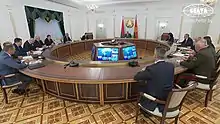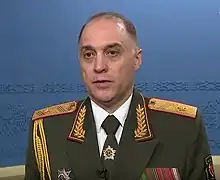Security Council of Belarus
The Security Council of Belarus (Belarusian: Савет бяспекі Рэспублікі Беларусь, Russian: Совет безопасности Республики Беларусь) is an interdepartmental body with a mandate to ensure the security of the Republic of Belarus. It considers internal and external affairs of the state with regard to the interest of maintaining security and defense. The Council was established upon the adoption of Resolution +1249 on 15 November 1991. The current Secretary of the Council is Alexander Volfovich.[1]
.svg.png.webp) |
|---|
|
|
|
|
History
It was established on November 15, 1991, when the Supreme Soviet of Belarus approved decision No. 1249, which established a 14 member Security Council, which included the then Commander of the Belarusian Military District. In accordance with the 1994 Belarusian Constitution, the chairman of the council was the President of Belarus, in their position as head of state and Commander-in-chief. In 1997, the Security Council apparatus, headed by the State Secretary, was renamed to the secretariat.[2][3]
Powers
Security Council's powers include:[4]
- Submitting proposals to the President regarding domestic and foreign policies
- Coordinate activities of government authorities
- Put forward early solutions to prevent emergency situations
Increased powers

In April 2021, President Lukashenko announced intentions to amend existing statutes for the emergency transfer of presidential power, making the Security Council the collective head of state should the President be killed. The Prime Minister would head the security council in place of the president.[5][6][7] He signed the decree on 9 May, after the Victory Day celebrations.[8] Justifying the decision, he noted that two-thirds of the council are civilians.[9]
Composition of members
It is currently composed of 20 people:
- President of Belarus
- Prime Minister of Belarus
- Chairman of the House of Representatives
- Chairman of the Council of the Republic
- Chairman of the Supreme Court
- Head of the Presidential Administration of Belarus
- State Secretary
- Prosecutor General
- Chairman of the National Bank
- Chairman of the State Security Committee of the Republic of Belarus
- Minister of Defense
- Minister of Foreign Affairs
- Minister of Internal Affairs
- Minister of Emergency Situations
- Chairman of the Investigation
- Chief of the General Staff
Viktor Lukashenko, the senior son of President Alexander Lukashenko, is also a member of the council (since January 2007), being the National Security Advisor.[10]
State Secretaries
- Viktor Sheiman (1994—November 27, 2000)
- Ural Latypov (November 27, 2000—September 12, 2001)
- Gennady Nevyglas (September 12, 2001—July 15, 2008)
- Yuri Zhadobin (July 15, 2008—December 4, 2009)
- Leonid Maltsev (December 4, 2009—December 5, 2013)
- Alexander Mezhuyev (December 5, 2013—November 4, 2015)
- Stanislav Zas (November 4, 2015—January 20, 2020)
- Andrei Ravkov (January 20-September 3, 2020)
- Valery Vakulchik (September 3, 2020—October 29, 2020)[11]
- Alexander Volfovich (since January 26, 2021)[12]
References
- Станіслаў Шушкевіч Закон Рэспублікі Беларусь ад 3 лістапада 1992 г. аб абароне
- "pravoby.info". www.pravoby.info.
- "Канстытуцыя 1994 года".
- "Security Council of the Republic of Belarus | Official Internet Portal of the President of the Republic of Belarus". president.gov.by. Retrieved 2021-05-18.
- "Lukashenko says $10 mln allocated for his assassination". TASS.
- "Lukashenko to amend emergency transfer of presidential power - Belta". news.yahoo.com.
- "Lukashenko decree to give council power in case of emergency". amp.dw.com.
- "Lukashenko signs decree to amend emergency transfer of power - Belta". Reuters. 2021-05-09. Retrieved 2021-05-10.
- "Lukashenko: Security Council will play a bigger role in Belarus". eng.belta.by. 2021-05-18. Retrieved 2021-05-18.
- "Виктор Лукашенко". TUT.by. Retrieved 23 March 2019.
- "Belarusian leader reshuffles security chiefs in face of mass protests" – via mobile.reuters.com.
- "Лукашенко уверен, что Белоруссию будут и дальше "шатать и раскачивать" - РИА Новости, 26.01.2021". ria.ru.
